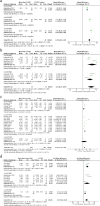Translucency of recent zirconia materials and material-related variables affecting their translucency: a systematic review and meta-analysis
- PMID: 38443872
- PMCID: PMC10913643
- DOI: 10.1186/s12903-024-04070-7
Translucency of recent zirconia materials and material-related variables affecting their translucency: a systematic review and meta-analysis
Abstract
Background: Recent forms of translucent zirconia material have been developed, offering a wide range of options and varieties for enhancing aesthetics, making it a preferred choice in the field of prosthetic dentistry. However, there is insufficient understanding regarding the recent types of zirconia materials and their optical behavior. Understanding the variables that influence the translucency of zirconia and identifying strategies to enhance its esthetics are crucial.
Purpose: The current systemic review highlights a comprehensive understanding of different zirconia generations in relation to their optical characteristics and evaluates material-related variables affecting their translucency.
Methods: The present review studied in-vitro studies that evaluated the optical characteristics of different yttria content of yttria stabilized materials. The topics explored were: (1) the different zirconia material generations and their optical behavior; (2) material-related factors that affect their translucency. The research was restricted to online publication in the English language from July 1, 2010, to July 31, 2023, using PubMed, Scopus, and Science Direct resources. The search key terms and their combinations were "zirconia," "translucent zirconia," "cubic zirconia," "highly translucent zirconia," "yttria partially stabilized zirconia," "monolithic zirconia," "translucency," "optical properties," and "light transmission."
Results: The data obtained from fifty-three studies addressed the optical characteristics of various zirconia generations. They reported that changing yttria content had a significant impact on translucency. Different kinds of zirconia ceramics of the same generation have varying translucencies. Achieving optimum aesthetics with monolithic zirconia is challenging due to factors related to material aspects such as the presence of additives, point defects, microstructure, thickness, phase distribution, and sintering conditions.
Conclusions: Newly developed monolithic dental zirconia ceramics have improved aesthetics and translucency. However, additional research is necessary to evaluate their performance and long-term durability.
Trial registration: This systematic review was registered in PROSPERO, under number CRD42023474482.
Keywords: Cubic zirconia; Highly translucent zirconia; Monolithic zirconia; Optical properties; Translucency; Yttria stabilized zirconia.
© 2024. The Author(s).
Conflict of interest statement
The authors declare no competing interests.
Figures



Similar articles
-
Factors affecting the translucency of monolithic zirconia ceramics: A review from materials science perspective.Dent Mater J. 2020 Jan 31;39(1):1-8. doi: 10.4012/dmj.2019-098. Epub 2019 Aug 10. Dent Mater J. 2020. PMID: 31406098 Review.
-
Trade-off between fracture resistance and translucency of zirconia and lithium-disilicate glass ceramics for monolithic restorations.Acta Biomater. 2019 Jun;91:24-34. doi: 10.1016/j.actbio.2019.04.043. Epub 2019 Apr 26. Acta Biomater. 2019. PMID: 31034947
-
Effects of Aging on the Color and Translucency of Monolithic Translucent Y-TZP Ceramics: A Systematic Review and Meta-Analysis of In Vitro Studies.Biomed Res Int. 2021 Jan 25;2021:8875023. doi: 10.1155/2021/8875023. eCollection 2021. Biomed Res Int. 2021. PMID: 33575352 Free PMC article.
-
Aging resistance, mechanical properties and translucency of different yttria-stabilized zirconia ceramics for monolithic dental crown applications.Dent Mater. 2018 Jun;34(6):879-890. doi: 10.1016/j.dental.2018.03.006. Epub 2018 Mar 26. Dent Mater. 2018. PMID: 29598882
-
Effect of sintering time on microstructure and optical properties of yttria-partially stabilized monolithic zirconia.Dent Mater. 2023 Dec;39(12):1169-1179. doi: 10.1016/j.dental.2023.10.012. Epub 2023 Oct 14. Dent Mater. 2023. PMID: 37845165
Cited by
-
Color Stability of Three Ceramics After Thermocycling in Coffee, Black Tea, Cola, and Water: An In Vitro Study.Int J Dent. 2025 Aug 21;2025:6965595. doi: 10.1155/ijod/6965595. eCollection 2025. Int J Dent. 2025. PMID: 40894184 Free PMC article.
-
The impact of aging and thickness on flexural strength of various zirconia ceramics.BMC Oral Health. 2024 Aug 20;24(1):967. doi: 10.1186/s12903-024-04745-1. BMC Oral Health. 2024. PMID: 39164712 Free PMC article.
References
-
- Johnston WM, Ma T, Kienle BH. Translucency parameter of colorants for maxillofacial prostheses. Int J Prosthodont. 1995;8:79–86. - PubMed
-
- Soares PV, Spini PH, Carvalho VF, Souza PG, Gonzaga RC, Tolentino AB, Machado AC. Esthetic rehabilitation with laminated ceramic veneers reinforced by lithium disilicate. Quintessence Int. 2014;45:129–133. - PubMed
Publication types
MeSH terms
Substances
LinkOut - more resources
Full Text Sources

